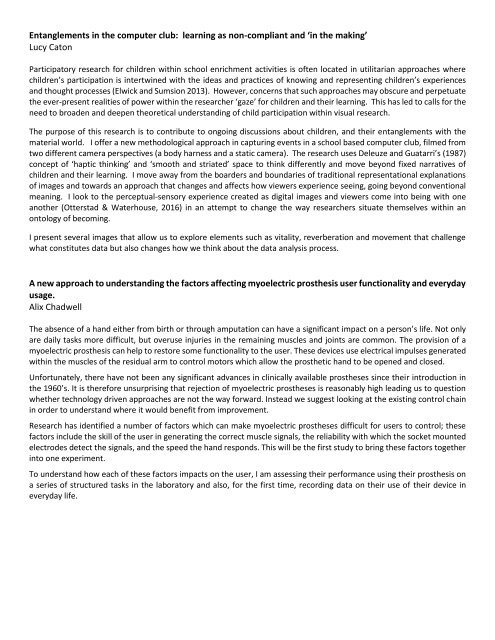Conference Programme FULL (1)
Create successful ePaper yourself
Turn your PDF publications into a flip-book with our unique Google optimized e-Paper software.
Entanglements in the computer club: learning as non-compliant and ‘in the making’<br />
Lucy Caton<br />
Participatory research for children within school enrichment activities is often located in utilitarian approaches where<br />
children’s participation is intertwined with the ideas and practices of knowing and representing children’s experiences<br />
and thought processes (Elwick and Sumsion 2013). However, concerns that such approaches may obscure and perpetuate<br />
the ever-present realities of power within the researcher ‘gaze’ for children and their learning. This has led to calls for the<br />
need to broaden and deepen theoretical understanding of child participation within visual research.<br />
The purpose of this research is to contribute to ongoing discussions about children, and their entanglements with the<br />
material world. I offer a new methodological approach in capturing events in a school based computer club, filmed from<br />
two different camera perspectives (a body harness and a static camera). The research uses Deleuze and Guatarri’s (1987)<br />
concept of ‘haptic thinking’ and ‘smooth and striated’ space to think differently and move beyond fixed narratives of<br />
children and their learning. I move away from the boarders and boundaries of traditional representational explanations<br />
of images and towards an approach that changes and affects how viewers experience seeing, going beyond conventional<br />
meaning. I look to the perceptual-sensory experience created as digital images and viewers come into being with one<br />
another (Otterstad & Waterhouse, 2016) in an attempt to change the way researchers situate themselves within an<br />
ontology of becoming.<br />
I present several images that allow us to explore elements such as vitality, reverberation and movement that challenge<br />
what constitutes data but also changes how we think about the data analysis process.<br />
A new approach to understanding the factors affecting myoelectric prosthesis user functionality and everyday<br />
usage.<br />
Alix Chadwell<br />
The absence of a hand either from birth or through amputation can have a significant impact on a person’s life. Not only<br />
are daily tasks more difficult, but overuse injuries in the remaining muscles and joints are common. The provision of a<br />
myoelectric prosthesis can help to restore some functionality to the user. These devices use electrical impulses generated<br />
within the muscles of the residual arm to control motors which allow the prosthetic hand to be opened and closed.<br />
Unfortunately, there have not been any significant advances in clinically available prostheses since their introduction in<br />
the 1960’s. It is therefore unsurprising that rejection of myoelectric prostheses is reasonably high leading us to question<br />
whether technology driven approaches are not the way forward. Instead we suggest looking at the existing control chain<br />
in order to understand where it would benefit from improvement.<br />
Research has identified a number of factors which can make myoelectric prostheses difficult for users to control; these<br />
factors include the skill of the user in generating the correct muscle signals, the reliability with which the socket mounted<br />
electrodes detect the signals, and the speed the hand responds. This will be the first study to bring these factors together<br />
into one experiment.<br />
To understand how each of these factors impacts on the user, I am assessing their performance using their prosthesis on<br />
a series of structured tasks in the laboratory and also, for the first time, recording data on their use of their device in<br />
everyday life.


